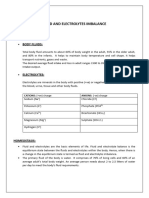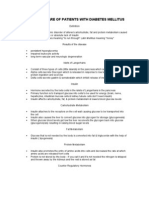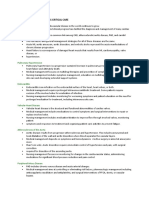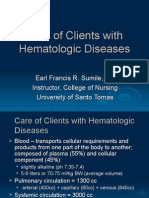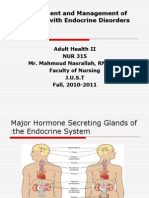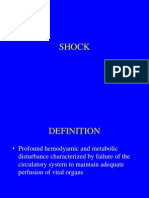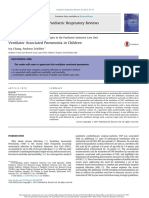Endocrine Disorders
Endocrine Disorders
Uploaded by
Irish OrleansCopyright:
Available Formats
Endocrine Disorders
Endocrine Disorders
Uploaded by
Irish OrleansCopyright
Available Formats
Share this document
Did you find this document useful?
Is this content inappropriate?
Copyright:
Available Formats
Endocrine Disorders
Endocrine Disorders
Uploaded by
Irish OrleansCopyright:
Available Formats
Assessment and Management of Patients with Endocrine disorders: ENDOCRINE GLANDS - secrete their products directly into the
blood stream *NEGATIVE FEEDBACK EFFECT - the mechanism for regulating hormone concentration in the blood stream which is important in regulation of many biologic process
8 ENDOCRINE GLANDS: 1. 2. 3. 4. 5. 6. 7. 8. Pineal Gland Pituitary Gland Thyroid Gland Parathyroid Gland Thymus Adrenal Gland Pancreas Ovaries/Testes
CLASSIFICATION AND ACTION OF HORMONES:
Hormones
1.
STEROID HORMONES
Ex. Hydrocortisone -
smaller size and higher lipid solubility can penetrate with cell membranes interact with intracellular receptors Interacts with receptor site in the cell surface Stimulates the intracellular enzyme, andenyl cyclase
PEPTIDE PROTEIN HORMONES Ex. Insulin *adenyl cyclase alters enzyme activity inside the cell (cyclic adenosine monophosphate) nd - becomes a 2 messenger 3. AMINE HORMONE Ex. Epinephrine, Norepinephrine
2.
Endocrine System
Mechanism of action is similar with peptide hormone Stimulates SNS
DIFFERENCE BETWEEN PEPTIDE AND STEROID HORMONES
Nervous System
Immune System
STEROIDS Slow-acting, long lasting Usually end in one Ex: Progesterone, Testosterone
PEPTIDES Fast-acting, short-lived Made of proteins Ex: Insulin, ADH
*Hormone secreted by the endocrine system are affected largely on the structures of the CNS such as the HYPOTHALAMUS (stimulates the PG) and beneath, the pituitary influences he function of a large no of endocrine glands. HYPOTHALAMUS controls the release of pituitary hormone Rapid action by the CNS is balanced by a slower hormonal action
HYPOPHYSIS other name of pituitary gland Known as the master gland Round structure about 1.25cm (1/2 inch) in diameter located at inferior aspect of the brain
Functions POSTERIOR VASOPRESSIN or ADH Controls the excretion of water by the kidney Secretion is stimulated by an in the osmolality of the blood by a of BP OXYTOCIN Facilitates milk ejection during lactation and force of uterine contractions during labor and delivery Stimulated during pregnancy or childhood ANTERIOR Growth Hormone / Stimulates growth of Somatotropin bones and muscles Promotes protein synthesis and fat metabolism CHO metabolism glucose level in the blood PROLACTIN Acts on the breast to stimulate milk production ACTH Adenocorticotropic Stimulates synthesis Hormone / Corticotropin and secretion of adrenal cortical hormones TSH Thyroid Stimulating Stimulates synthesis Hormone and secretion of thyroid hormones FSH Follicle Stimulating Female: stimulates growth Hormone of ovarian follicle, ovulation Male: stimulates sperm production LH Luteinizing Hormone Female: stimulates devt of corpus luteum, release of oocyte, production of estrogen and progesterone Male: stimulates secretion of testosterone, devt of interstitial tissues of testes
THYROID HORMONES THYROID 5cm long, 3 cm wide Butter-fly shaped on the lower neck anterior of trachea Has 2 lateral lobes connected by an isthmus (palpable)
Regulation of Thyroid Hormone: md
ASSESSMENT AND DIAGNOSTIC TEST Thyroid gland is inspected by: Identification of its landmark Lower neck region between sternocleidomastoid muscles (check swelling or asymmetry) Instruct to extend neck slightly and swallow Palpation Check size, shape, consistency, symmetry, tenderness
T3 and T4 controlled by TSH + hypothalamus from anterior PG and it release
THYROID HORMONES: 1. 2. 3. Triiodotyronine (T3) Thyroxine (T4) Calcitonin
TRH (thyrotropin-releasing hormone) secreted by hypothalamus, helps modulate the release of TSH from pituitary
CHEMICAL: Iodine T3 Contains 3 iodine atoms 5x more potent than T4 More rapid metabolic action T4 Contains 4 iodine atoms Weak hormone Maintains metabolism on a steady state
Increase release by TSH of T3 and T4 in the blood to the target organs or called NEGATIVE FEEDBACK
FUNCTIONS OF T3 and T4:
ISTHMUS only portion of thyroid that is normally palpable If palpation discloses an enlarged thyroid gland Both lobes should be auscultated (there should be BRUIT normal blood circulation) Tenderness, enlargement, modularity (requires referral)
Control cellular metabolic activity Accelerate metanolic processes by levels of specific enzymes Influence cell replication and important for brain development Necessary for normal growth FUNCTION Secreted in response to high levels of calcium and reduces plasma level of calcium by its deposition in bone Essential to the thyroid gland for synthesis of its hormones Major derangement of iodine deficiency is caused by alteration of thyroid function
-synthesized and stored bound to proteins in the cell until its released in blood stream
- 75% bound to thyroxine-binding albumin
THYROID HORMONE CALCITONIN/ THYROCALCITONIN
IODINE
You might also like
- Ghosts in The Nursery Paper PDFDocument35 pagesGhosts in The Nursery Paper PDFMarily Rivera100% (2)
- Brain HerniationDocument40 pagesBrain HerniationAnusha VergheseNo ratings yet
- Endocrine System NOTESDocument2 pagesEndocrine System NOTEShuang renjunNo ratings yet
- Urinary SystemDocument2 pagesUrinary SystemCharlayne AnneNo ratings yet
- Assessment and Management of Patients With Endocrine DisordersDocument11 pagesAssessment and Management of Patients With Endocrine DisordersLesley GonzalezNo ratings yet
- EndocrineDocument12 pagesEndocrineAna FelNo ratings yet
- Fluid and Electrolyte Imbalance PDFDocument21 pagesFluid and Electrolyte Imbalance PDFShafaq AlamNo ratings yet
- Case Study On Acute GlomerulonephritisDocument3 pagesCase Study On Acute GlomerulonephritisDalene Erika GarbinNo ratings yet
- Acute Respiratory InfectionsDocument18 pagesAcute Respiratory InfectionsEmilyRose17No ratings yet
- Medsurg 3 Exam 1Document55 pagesMedsurg 3 Exam 1Melissa Blanco100% (1)
- Nursing Care of Patients With Diabetes MellitusDocument11 pagesNursing Care of Patients With Diabetes MellitusMarcus, RN100% (32)
- Stages of ShockDocument3 pagesStages of Shockshalimgay100% (2)
- Eyes and EarsDocument17 pagesEyes and Earsdlneisha61100% (2)
- Fluid and Electrolyte BalanceDocument295 pagesFluid and Electrolyte BalanceAnuchithra Radhakrishnan100% (1)
- Oncology NursingDocument15 pagesOncology NursingArdrina Sappari100% (1)
- NCM112 Module 2 Day 2 Immune SystemDocument12 pagesNCM112 Module 2 Day 2 Immune SystemAndrea DaracanNo ratings yet
- Endocrine SystemDocument43 pagesEndocrine Systemwieka mawie100% (1)
- Renal System 1 PowerPoint PresentationDocument40 pagesRenal System 1 PowerPoint PresentationFasie Dragos100% (1)
- Fluid and Electrolytes CDocument112 pagesFluid and Electrolytes CJoyjoy FriasNo ratings yet
- Anatomy and Physiology of BloodDocument10 pagesAnatomy and Physiology of Bloodaoi_rachelle100% (1)
- Fluid and ElectrolytesDocument13 pagesFluid and ElectrolytesMarcus, RN100% (7)
- Endocrine DisordersDocument16 pagesEndocrine DisordersEiffel AnchetaNo ratings yet
- Fluid and Electrolytes DisturbancesDocument8 pagesFluid and Electrolytes DisturbancesRoselily Flores CoquillaNo ratings yet
- Myasthenia GravisDocument16 pagesMyasthenia Graviszarka wahid buxNo ratings yet
- GI Ch.44-47Document40 pagesGI Ch.44-47W11795800% (1)
- 5 Cardiovascular DisordersDocument4 pages5 Cardiovascular DisordersChristian Joseph OpianaNo ratings yet
- Chronic Renal FailureDocument29 pagesChronic Renal Failuregeorgia.langNo ratings yet
- Transes EndoDocument20 pagesTranses EndoISABEL REGASPINo ratings yet
- Drugstudy and SoapieDocument17 pagesDrugstudy and SoapieYasi EcheniqueNo ratings yet
- NCM 116: Care of Clients With Problems in Nutrition and Gastrointestinal, Metabolism and Endocrine,, Acute and ChronicDocument18 pagesNCM 116: Care of Clients With Problems in Nutrition and Gastrointestinal, Metabolism and Endocrine,, Acute and ChronicSIJINo ratings yet
- Pulmonary PathoPhysiologyDocument45 pagesPulmonary PathoPhysiologySuliman Garalleh100% (1)
- Renal and Urinary SystemDocument5 pagesRenal and Urinary SystemStaceyNo ratings yet
- Hematologic ProblemsDocument26 pagesHematologic Problemsapi-3735995100% (2)
- Disorders of Endocrine GlandDocument14 pagesDisorders of Endocrine Glandaklimaetsy1099No ratings yet
- MS NeuroDocument124 pagesMS Neuroreccelle_pre295747No ratings yet
- Nursing Care of Clients With Urinary Tract DisordersDocument70 pagesNursing Care of Clients With Urinary Tract DisordersYuu Ayu'k LifestarNo ratings yet
- AUTOIMMUNEDocument75 pagesAUTOIMMUNEEva Boje-JugadorNo ratings yet
- 418 Lilo Nidoira Case Scenario.Document7 pages418 Lilo Nidoira Case Scenario.Raymart SubejanoNo ratings yet
- Assessment and Management of Patients With Endocrine DisordersDocument46 pagesAssessment and Management of Patients With Endocrine Disordersamal100% (2)
- Fluids and Electrolytes FinalDocument62 pagesFluids and Electrolytes Finalabbas khanNo ratings yet
- Ms 1 Integumentary NursingDocument10 pagesMs 1 Integumentary NursingTrinity Veach100% (1)
- Benign Prostatic HyperplasiaDocument5 pagesBenign Prostatic HyperplasiajustmiitmiideeNo ratings yet
- ShockDocument24 pagesShockYaacub IbrahimNo ratings yet
- Eye DisordersDocument7 pagesEye DisordersClara De GuzmanNo ratings yet
- Endocrine Med-Surg Slide Show Presentation (Nursing)Document43 pagesEndocrine Med-Surg Slide Show Presentation (Nursing)loveoverprideNo ratings yet
- Fluid, Electrolyte, and Acid-BaseDocument6 pagesFluid, Electrolyte, and Acid-BaseRaquel MonsalveNo ratings yet
- Nursing Care Management 106Document82 pagesNursing Care Management 106maynard baird100% (6)
- Pathophysiology On Cellulitis On Left Facial AreaDocument9 pagesPathophysiology On Cellulitis On Left Facial AreaAdiNo ratings yet
- Hematologic NursingDocument80 pagesHematologic NursingbeshyNo ratings yet
- Endocrine Disorders TableDocument6 pagesEndocrine Disorders TablebarbaraNo ratings yet
- Renal MedsurgDocument14 pagesRenal MedsurgCliff Lois ╭∩╮⎷⎛⎝⎲⏝⏝⎲⎠⎷⎛╭∩╮ Ouano100% (1)
- Shock TypesDocument25 pagesShock TypesMuqeet76No ratings yet
- Sinus Bradycardia: I. Sinus Dysrhythmias Description ManagementDocument4 pagesSinus Bradycardia: I. Sinus Dysrhythmias Description ManagementMargueretti Delos ReyesNo ratings yet
- Eman Question MSDocument6 pagesEman Question MSPaul ignacioNo ratings yet
- Acute and Chronic PancreatitisDocument8 pagesAcute and Chronic PancreatitisIsabel CastilloNo ratings yet
- Blood TransfusionDocument4 pagesBlood TransfusionYnaffit Alteza UntalNo ratings yet
- Med-Surg LEWIS 47 Final Foofed UpDocument10 pagesMed-Surg LEWIS 47 Final Foofed Uphariniliaankhen100% (1)
- Ventricular Septal Defect, A Simple Guide To The Condition, Treatment And Related ConditionsFrom EverandVentricular Septal Defect, A Simple Guide To The Condition, Treatment And Related ConditionsNo ratings yet
- A Simple Guide to Hypovolemia, Diagnosis, Treatment and Related ConditionsFrom EverandA Simple Guide to Hypovolemia, Diagnosis, Treatment and Related ConditionsNo ratings yet
- Name Uses Sources: Oxygen Sulfur Magnesium Chlorine PotassiumDocument1 pageName Uses Sources: Oxygen Sulfur Magnesium Chlorine PotassiumIrish OrleansNo ratings yet
- Pressure UlcerDocument1 pagePressure UlcerIrish OrleansNo ratings yet
- Definition of TermsDocument3 pagesDefinition of TermsIrish OrleansNo ratings yet
- Total Bacterial CounrDocument10 pagesTotal Bacterial CounrIrish OrleansNo ratings yet
- BDDCS Predictions, Self-Correcting Aspects of BDDCS Assignments, BDDCS Assignment Corrections, and Classification For More Than 175 Additional DrugsDocument10 pagesBDDCS Predictions, Self-Correcting Aspects of BDDCS Assignments, BDDCS Assignment Corrections, and Classification For More Than 175 Additional DrugsBagoes AsNo ratings yet
- Treatment Processes Factsheet FINALDocument6 pagesTreatment Processes Factsheet FINALpennywiserNo ratings yet
- Effects of Ageing On Smell and TasteDocument9 pagesEffects of Ageing On Smell and Tasteapi-368453103No ratings yet
- Journal 1 - Plasenta PreviaDocument5 pagesJournal 1 - Plasenta Previarizky ferdina kevinNo ratings yet
- 91 Docx (Surgical)Document21 pages91 Docx (Surgical)MARTIN BOATENGNo ratings yet
- Biomarker Terminology Speaking The Same LanguageDocument12 pagesBiomarker Terminology Speaking The Same LanguageSuhendra Mandala ErnasNo ratings yet
- Paracetamol Use GuideDocument13 pagesParacetamol Use GuideShashiprakash KshatriyaNo ratings yet
- Physiotherapy Functional AssessmentDocument2 pagesPhysiotherapy Functional AssessmentILR 2019No ratings yet
- Classification: by DepthDocument7 pagesClassification: by Depthstephanie_neri_2No ratings yet
- Bioethics Animal Paper PresentationDocument14 pagesBioethics Animal Paper Presentationtimar iaNo ratings yet
- Lec 1 Introduction To EndodonticsDocument20 pagesLec 1 Introduction To Endodonticsبراءة أحمد السلاماتNo ratings yet
- Medical Terminology and Common Ambulance Abbrieviations - 6slideDocument8 pagesMedical Terminology and Common Ambulance Abbrieviations - 6slideuzman1243No ratings yet
- Bharti 3Document4 pagesBharti 3bhartigonnadeNo ratings yet
- Electrosurgery and Energized Dissection: Basic SkillsDocument5 pagesElectrosurgery and Energized Dissection: Basic SkillsMadalina PişteaNo ratings yet
- Ficus ReligiosaDocument3 pagesFicus ReligiosaAbdul Sami Abdul LatifNo ratings yet
- Neurology NotesDocument31 pagesNeurology NotesArif Setyawan75% (4)
- About USCDocument12 pagesAbout USCbrooklynsnowNo ratings yet
- Pediatric Vital SignsDocument6 pagesPediatric Vital Signskaychi z100% (2)
- Pyote 3Document6 pagesPyote 3Carolina Félix PadillaNo ratings yet
- 6 Ab 2Document3 pages6 Ab 2Erko100% (1)
- ECG Changes in Left Ventricular HypertrophyDocument25 pagesECG Changes in Left Ventricular HypertrophyMuhammad AsifNo ratings yet
- Acute Pain and Impaired Skin Integrity PostopDocument9 pagesAcute Pain and Impaired Skin Integrity PostopKach Kurrs0% (1)
- Slide Product Brilinta Crestor AsmihaDocument3 pagesSlide Product Brilinta Crestor AsmihaMaretha Dyah AnggrainiNo ratings yet
- Ventilator Associated Pneumonia in ChildrenDocument7 pagesVentilator Associated Pneumonia in ChildrendarlingcarvajalduqueNo ratings yet
- Perimount VavleDocument4 pagesPerimount VavleTanh NguyenNo ratings yet
- Xiaoming Zhu China's Technology Innovators Selected Cases On Creating and Staying Ahead of Business TrendsDocument193 pagesXiaoming Zhu China's Technology Innovators Selected Cases On Creating and Staying Ahead of Business TrendsrezasattariNo ratings yet
- Jaysonresume 2Document2 pagesJaysonresume 2api-291938337No ratings yet
- Uncontrolled Type 1 Diabetes Mellitus With Lung Tuberculoma and Bilateral Hydronephrosis in 13-Year-Old GirlDocument5 pagesUncontrolled Type 1 Diabetes Mellitus With Lung Tuberculoma and Bilateral Hydronephrosis in 13-Year-Old GirlAnggia Prameswari WardhanaNo ratings yet
- Submandibular Phlegmon - Causes, Symptoms, Diagnosis and TreatmentDocument1 pageSubmandibular Phlegmon - Causes, Symptoms, Diagnosis and TreatmentTri Sakti Sunda RomdhoniNo ratings yet






